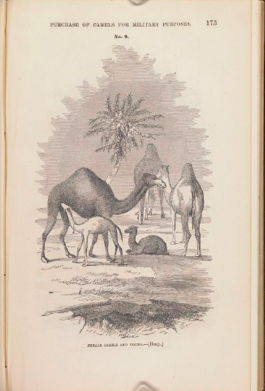 By Maria A. Windell (Guest Contributor)
By Maria A. Windell (Guest Contributor)
In May 1856, Captain David Dixon Porter, Major Henry Wayne, and the Supply dropped anchor of the coast of Indianola, Texas, and unloaded thirty-four camels to the care of the United States Army. Thus began the Army’s “Camel Corps” experiment. The experiment, however, was a short-lived and ill-fated one. While the camels adapted remarkably well to the climate and terrain of the US Southwest, US soldiers and horses proved ill-suited camel handlers and companions.
Although the “Camel Corps” experiment failed, and failed fairly quickly, a lot of consideration and support had gone into the decision to bring camels to the United States. On his travels Major Wayne was charged with consulting camel experts in England, France, and Tuscany, and the Report of the Secretary of War, produced for the Senate in 1857, includes extensive excerpts from several scientific and military texts on camels. For all of the Army’s scientific interest in the camels, though, some of the strangest and most amusing commentary on the camels focuses on the births of baby camels. This commentary highlights both cultural differences surrounding mother-child relationships and the degree of anthropomorphization that the camel births prompted. The appearance of baby camels, it seems, led military men straight into domestic discourse.
Six calves were born at sea as the Supply made its way from Turkey to the United States. Captain Porter allowed the Turkish caretakers who shipped with the Supply to handle the births of the first calves—to his great dismay. Porter blames the calves’ deaths upon “the Turkish mode of doing business,” which is to wrap the calf in a blanket immediately after its birth. The mother, he writes, subsequently “takes but little notice of her progeny; it is probable that she does not recognize it so wrapped up in a bundle of colored rags, or, if she does, is so disappointed with its appearance that she does not care about owning it.” When Porter and “the Bedouin” take charge of the next birth, and forgo swaddling the calf, the mother “testifie[s] much affection for it, not being shocked by the sight of the unsightly clothes by which the others had been so disguised, that the mothers did not recognize them as their own offspring.” Nineteenth-century Anglo-American domesticity creates certain expectations regarding affection, recognition, and mother-child bonding—and these expectations dictate Porter’s preferred camel birthing method. While Porter elsewhere praises the Turkish caretakers as “good, honest men . . . of a high[] order of intellect,” his assumption that the camels cannot recognize—or simply disown—blanket-wrapped calves is clearly based in part on his own dislike of those “colored rags.”
The fascination with baby camels extended well beyond the expedition. For instance, Harper’s Weekly, a popular newspaper, might have discussed any number of issues related to the camel experiment and “native” US camels. The Army tried to frame its interest in camels in scientific and military terms. But as various comments about baby camels show, images of domesticity and motherhood were just as important to the ways in which US Americans understood these “exotic” animals.
Maria A. Windell is Assistant Professor of English at the University of Colorado, Boulder. She works on nineteenth-century US literature in transnational context.
Image Citation:
Report of the Secretary of War, Communicating, in Compliance with a Resolution of the Senate of February 2, 1857, Information Respecting the Purchase of Camels for the Purposes of Military Transportation. Albert and Shirley Small Special Collections Library, University of Virginia.
